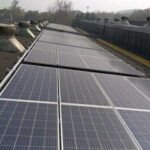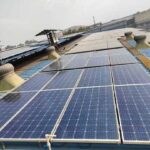Solar Power System Efficiency: How to Calculate for Residential, Industrial & Commercial Use
Solar Power System Efficiency: How to Calculate for Residential, Industrial & Commercial Use
Pre-Module Losses | Tolerance of rated power | Consider that the module does not deliver the power as stated in the data sheet. Manufacturers provide a tolerance, often up to 5%. |
Shadows | Shadows may be caused by trees, chimneys etc. Depending on the stringing of the cells, even partial shading may have a significant effect. | |
Dirt | Losses due to dirt up to 4% in temperate regions with some frequent rain. Up to 25% in arid regions with only seasonal rain and dust. | |
Snow | Dependent on location and maintenance effort. | |
Reflection | Reflection losses increase with the angle of incidence. Also, this effect is less pronounced in locations with a large proportion of diffuse light, i.e. clouds. | |
Module Losses | Conversion | The nominal efficiency is given by the manufacturer for standard conditions. |
Thermal losses | With increasing temperatures, conversion losses increase. These losses depend on irradiance (i.e. location), mounting method (glass, thermal properties of materials), and wind speeds. A very rough estimate is ~8% | |
System Losses ~ 14% | Wiring | Any cables have some resistance and therefore more losses. |
MPP | Ability of the MPP tracker in inverters to consistently find the maximum power point. | |
Inverter | Inverter efficiency | |
Mis-sized inverter | If the inverter is undersized, power is clipped for high intensity light. If it is oversized, the inverter’s efficiency will be too low for low intensity light. | |
Transformer | Transformer losses, in case where electricity has to be connected to a high-voltage grid( 11 KV and above ). | |
Operation & Maintenance | Downtime | Downtime for maintenance is usually very low for photovoltaic systems. |
Suggested Articles

India’s Solar Capacity Growth Slows Down in Q1 2023
India’s solar capacity growth slowed in Q1 2023. Explore the factors behind the slowdown and its impact on the country’s renewable energy progress.

Benefits of Solar Energy: Why Switching to Solar Makes Sense
Switching to solar energy offers numerous benefits, from lowering electricity bills to reducing your carbon footprint. This guide explores how solar power supports sustainable living, provides cost savings, and creates a cleaner environment for homes, businesses, and industries. Learn why adopting solar energy is not just smart, but essential for a greener future.

Top Solar Companies & Suppliers in Delhi/NCR – A Complete Guide
Looking for trusted solar panel suppliers in Delhi/NCR? Explore leading solar companies serving Gurgaon, Noida, Faridabad, Manesar, and Ghaziabad. Compare product quality, technology, and services to choose the right solar partner for your home, business, or factory.

How a String Monitoring Box Works in Residential Solar Systems
Understand how a string monitoring box helps track and protect your home solar panels for maximum efficiency and safety

100 kW Solar Power Plant in Indore – Latest Cost, Subsidy & Payback Period
A 100 kW solar plant in Indore costs around ₹40–55 lakh in, offering annual savings of up to ₹10 lakh and a payback period of 4–6 years. Learn about installation, maintenance, and ROI to make your solar investment worthwhile.

Everything you Need to Know about Bifacial Solar Panels technology
Learn how bifacial solar panels capture sunlight on both sides, boosting energy efficiency and maximizing solar power generation for homes and businesses.

6 Innovative Applications of Solar Energy You Should Know About
Explore how solar energy is revolutionizing daily life and industries. From solar-powered transport to smart cities, discover six groundbreaking solar applications shaping a cleaner, smarter future.

Higher Electricity Bills in Haryana as Fuel Surcharge Rises
Haryana consumers are facing higher electricity bills after the Haryana Electricity Regulatory Commission (HERC) approved a fuel surcharge hike for DHBVN and UHBVN areas. The increase reflects rising fuel and power purchase costs, directly impacting domestic, commercial, and industrial users across the state.